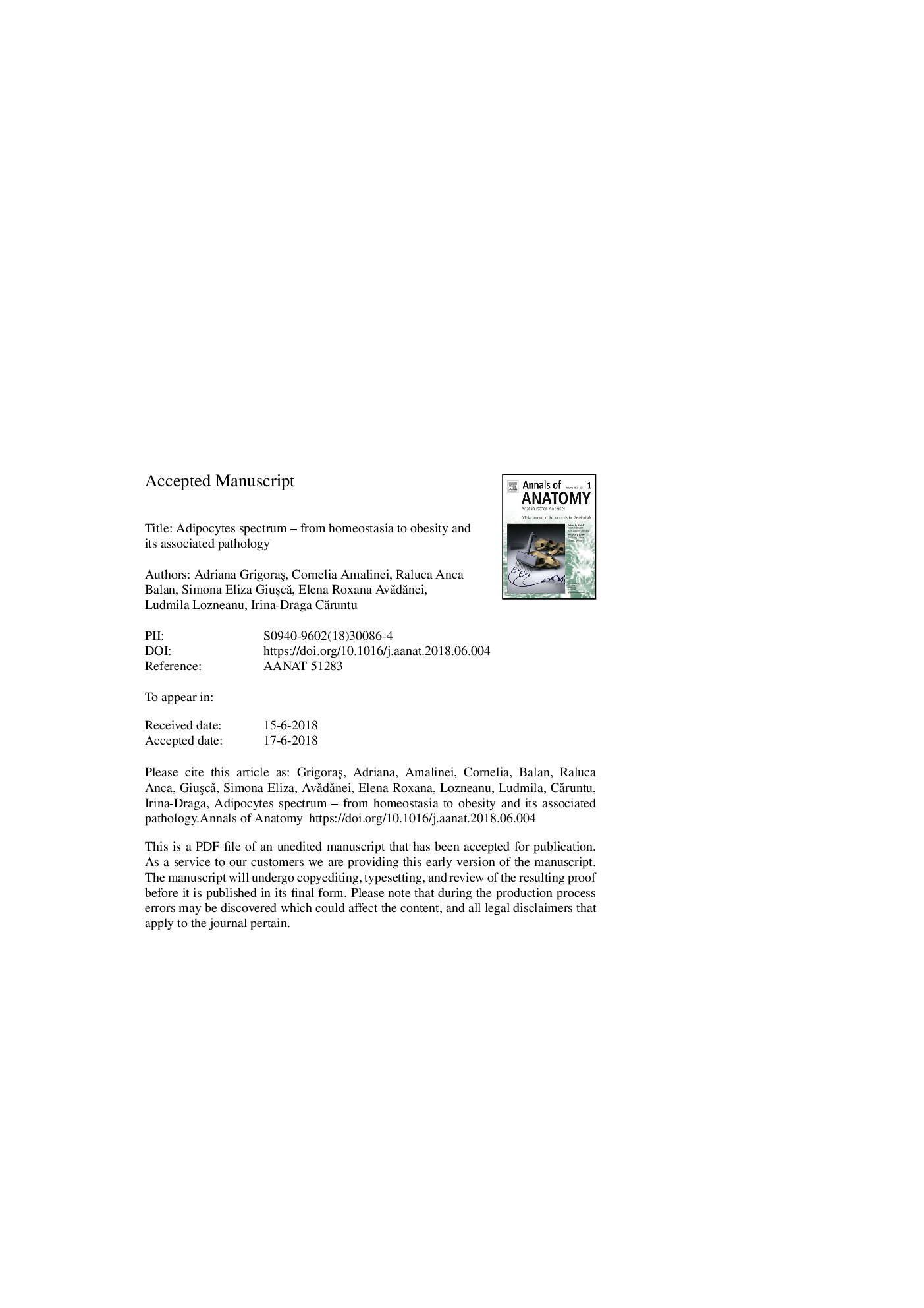| کد مقاله | کد نشریه | سال انتشار | مقاله انگلیسی | نسخه تمام متن |
|---|---|---|---|---|
| 8460233 | 1548976 | 2018 | 71 صفحه PDF | دانلود رایگان |
عنوان انگلیسی مقاله ISI
Adipocytes spectrum - From homeostasia to obesity and its associated pathology
دانلود مقاله + سفارش ترجمه
دانلود مقاله ISI انگلیسی
رایگان برای ایرانیان
کلمات کلیدی
CREBCDKASPCOX-218F-fluorodeoxyglucoseFGFMIRMCP-1PPARγPOMCBATPRBIGF-IpKaGHRNGFFDGAP2SCA1pro-opiomelanocortinWntMC4RPAI-1NPRPET-CTARNTLRBP4EBFTbx1AQP7AdipoRLPLIRFIP-10RERHSLwingless-type MMTV integration site familyPDGFRαstem cell antigen 1Early B-cell factorPGC1αPVATMIP-1βPGI2G3PDHKLFPGF2αPLIN1CCAAT-enhancer-binding proteinsTCF21SHOX2UCPSREBP1FZD4DIO2Foxc2forkhead box C2Myf5FATP1NPY/AgRPPRDM16IMATPDK4RIP140PAXTMEMCIDEZIC1Angptl2Ob-RAsc-1Aquaporin-7GPR119Lhx8Tle3BMATTNFTGF-βLXRβhomeobox proteinKCNK3GATA binding proteinELOVL3serum amyloid A3receptor-interacting protein 140 - 140 پروتئین گیرنده گیرندهBDNF - BDNF یا فاکتور نورونزایی مشتقشده از مغز C/EBP - C / EBPC/EBP homologous protein - C / EBP پروتئین همولوگTGs - TG هاTZDs - TZD هاAdipocytes - آدیپوسیتALP - آلکالن فسفاتازAlkaline phosphatase - آلکالین فسفاتاز یا فسفاتاز قلیاییGATA - آمادهAngiotensin II - آنژیوتانسین دوAngiotensinogen - آنژیوتانسینوژنAtgl - اتگلinsulin - انسولینinsulin-like growth factor I - انسولین مانند عامل رشد Iinterleukin - اینترلوکینWhite adipose tissue - بافت چربی سفیدbrown adipose tissue - بافت چربی قهوه ایbone marrow adipose tissue - بافت چربی مغز استخوانperivascular adipose tissue - بافت چربی پرایسکولارSER - برای بودنTransforming growth factor β - تبدیل فاکتور رشد βThermogenesis - ترموژنزpositron emission tomography-computed tomography - توموگرافی کامپیوتری انتشارات پوزیترونCHOP - تکه کردنthiazolidinediones - تیازولیدیدونهاAng II - دومadipose stem cells - سلول های بنیادی چربیAge - سنcyclooxygenase 2 - سیکلوکوکسیژناز 2body mass index - شاخص توده بدنBMI - شاخص توده بدنیrough endoplasmic reticulum - شبکیه اندوپلاسمی خشنsmooth endoplasmic reticulum - صاف اندوپلاسمی صافinterferon regulatory factor - عامل تنظیمی اینترفرونMyogenic Factor 5 - عامل فاکتور 5Krüppel-like factor - عامل کریپال مانندGranulocyte-colony stimulating factor - فاکتور تحریک گرانولیسیت کلنیnerve growth factor - فاکتور رشد عصبfibroblast growth factor - فاکتور رشد فیبروبلاستG-CSF - فاکتور محرک کُلونی گرانولوسیتtumor necrosis factor - فاکتور نکروز تومورadipose triglyceride lipase - لیپاز تری گلیسیرید چربیLipoprotein lipase - لیپو پروتئین لیپازCAR - ماشینmacrophage inflammatory protein-1β - ماکروفاژ التهابی پروتئین 1βBMP - مدیریت فرایند کسب و کارObesity - مرض چاقیMicroRNA - میکرو RNA Plasminogen activator inhibitor type 1 - نوع مهار کننده فعال کننده پلاسمینوژن 1monocyte chemoattractant protein 1 - پروتئین cheoattractant monocyte 1Retinol-binding protein 4 - پروتئین اتصال دهنده رتینول 4sterol regulatory element-binding protein 1 - پروتئین اتصال دهنده عصاره استرول 1interferon-γ-inducible protein 10 - پروتئین القا شده اینترفرون-γ 10Acylation stimulating protein - پروتئین تحریک کننده آکیلایتTransmembrane protein - پروتئین ترانزیتیUncoupling protein - پروتئین جدا کردنfatty acid transport protein 1 - پروتئین حمل و نقل اسید چرب 1retinoblastoma protein - پروتئین رتینوبلاستوماBone morphogenetic protein - پروتئین مورفوژنیک استخوانcAMP response element-binding protein - پروتئین واکنش القا کننده واکنش cAMPC-reactive protein - پروتئین واکنشی سیCRP - پروتئین واکنشی سی یا سی. آر. پی protein kinase A - پروتئین کیناز AProstaglandin F2α - پروستاگلاندین F2αProstaglandin I2 - پروستاگلاندین I2Body fat - چربی بدنWAT - چیAdiponectin gene - ژن آدیپونکتینcyclin-dependent kinase - کییناز وابسته به سیکلینPeroxisome proliferator-activated receptor gamma - گاما گیرنده گیرنده فعال پرولیفیزوم فعالglyceraldehyde 3-phosphate dehydrogenase - گلیسرولیدید 3-فسفات دهیدروژنازadiponectin receptor - گیرنده adiponectinPlatelet-derived growth factor receptor alpha - گیرنده آلفای فاکتور رشد حاصل از پلاکتinsulin receptor - گیرنده انسولینmelanocortin 4 receptor - گیرنده ملانوکورتین 4growth hormone receptor - گیرنده هورمون رشدglucocorticoids receptor - گیرنده گلوکوکورتیکوئیدها
موضوعات مرتبط
علوم زیستی و بیوفناوری
بیوشیمی، ژنتیک و زیست شناسی مولکولی
بیولوژی سلول
پیش نمایش صفحه اول مقاله

چکیده انگلیسی
Firstly identified by anatomists, the fat tissue is nowadays an area of intense research due to increased global prevalence of obesity and its associated diseases. Histologically, there are four types of fat tissue cells which are currently recognized (white, brown, beige, and perivascular adipocytes). Therefore, in this study we are reviewing the most recent data regarding the origin, structure, and molecular mechanisms involved in the development of adipocytes. White adipocytes can store triglycerides as a consequence of lipogenesis, under the regulation of growth hormone or leptin and adiponectin, and release fatty acids resulted from lipolysis, under the regulation of the sympathetic nervous system, glucocorticoids, TNF-α, insulin, and natriuretic peptides. Brown adipocytes possess a mitochondrial transmembrane protein thermogenin or UCP1 which allows heat generation. Recently, thermogenic, UCP positive adipocytes have been identified in the subcutaneous white adipose tissue and have been named beige adipocytes. The nature of these cells is still controversial, as current theories are suggesting their origin either by transdifferentiation of white adipocytes, or by differentiation from an own precursor cell. Perivascular adipocytes surround most of the arteries, exhibiting a supportive role and being involved in the maintenance of intravascular temperature. Thoracic perivascular adipocytes resemble brown adipocytes, while abdominal ones are more similar to white adipocytes and, consequently, are involved in obesity-induced inflammatory reactions. The factors involved in the regulation of adipose stem cells differentiation may represent potential pathways to inhibit or to divert adipogenesis. Several molecules, such as pro-adipogenic factors (FGF21, BMP7, BMP8b, and Cox-2), cell surface proteins or receptors (Asc-1, PAT2, P2RX5), and hypothalamic receptors (MC4R) have been identified as the most promising targets for the development of future therapies. Further investigations are necessary to complete the knowledge about adipose tissue and the development of a new generation of therapeutic tools based on molecular targets.
ناشر
Database: Elsevier - ScienceDirect (ساینس دایرکت)
Journal: Annals of Anatomy - Anatomischer Anzeiger - Volume 219, September 2018, Pages 102-120
Journal: Annals of Anatomy - Anatomischer Anzeiger - Volume 219, September 2018, Pages 102-120
نویسندگان
Adriana GrigoraÅ, Cornelia Amalinei, Raluca Anca Balan, Simona Eliza GiuÅcÄ, Elena Roxana AvÄdÄnei, Ludmila Lozneanu, Irina-Draga CÄruntu,